Comprehensive Business Plan: Nerd Patrol Computer Services Startup
VerifiedAdded on 2023/05/28
|20
|6260
|354
AI Summary
This document presents a detailed business plan for "Nerd Patrol," a computer and networking service company. The plan covers various aspects of the business, including an organizational overview with its mission, vision, and corporate objectives, as well as the proposed organizational structure and stakeholder mapping. It includes a market analysis using Porter's Five Forces, marketing strategies based on the 4Ps framework, and operational strategies detailing premises and service offerings. A significant portion of the plan is dedicated to financial planning, including initial capital requirements, operational expenses, projected profit and loss statements, balance sheets, ratio analysis, and a break-even point calculation. Furthermore, the plan addresses legal considerations, resource planning, risk mitigation strategies, limitations, and an exit strategy. It concludes with a timeline of planned achievements and a recommendation based on the project's overall feasibility. The plan also incorporates SWOT analysis, highlighting strengths, weaknesses, opportunities, and threats within the computer servicing market.

Business Plan
“Nerd Patrol”
“Nerd Patrol”
Paraphrase This Document
Need a fresh take? Get an instant paraphrase of this document with our AI Paraphraser
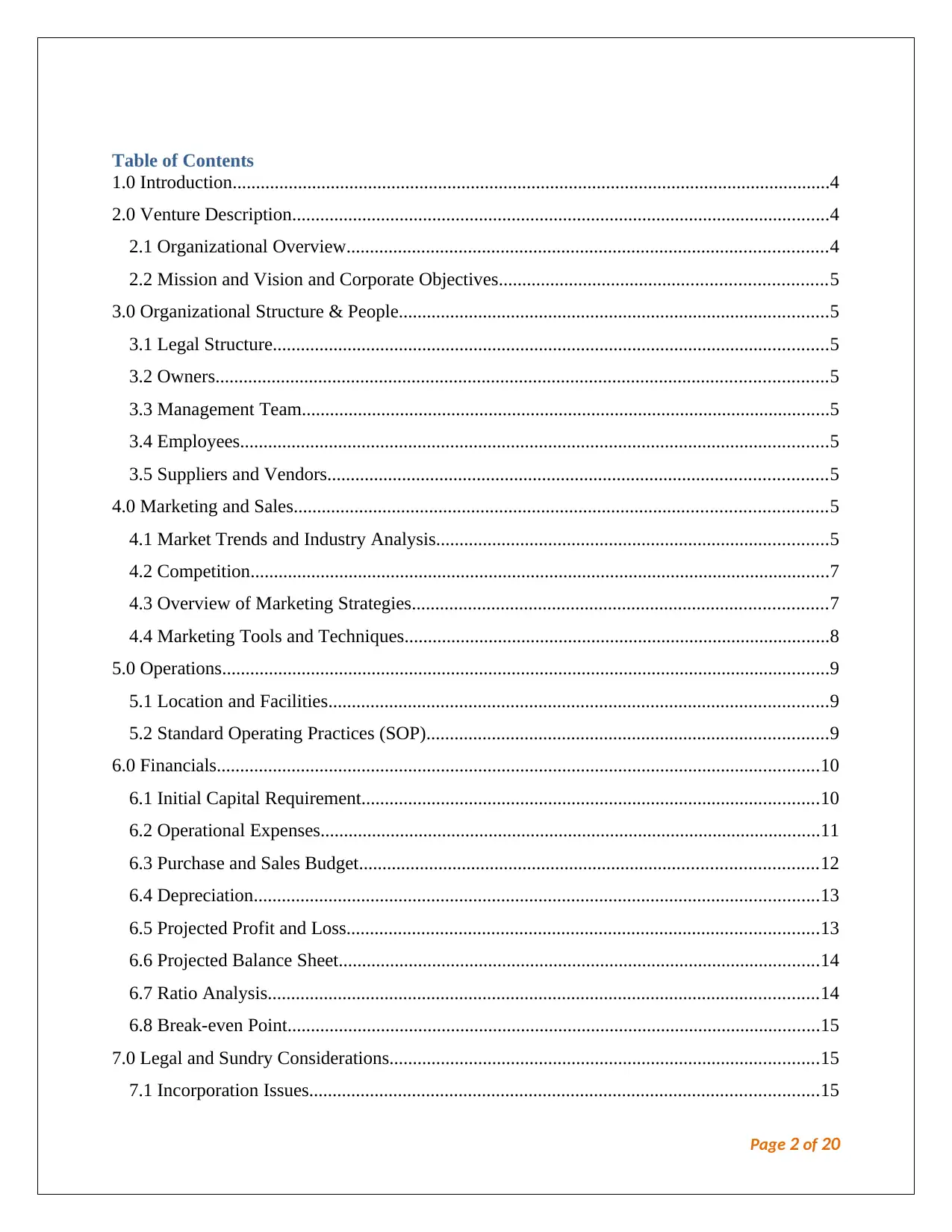
Table of Contents
1.0 Introduction................................................................................................................................4
2.0 Venture Description...................................................................................................................4
2.1 Organizational Overview.......................................................................................................4
2.2 Mission and Vision and Corporate Objectives......................................................................5
3.0 Organizational Structure & People............................................................................................5
3.1 Legal Structure.......................................................................................................................5
3.2 Owners...................................................................................................................................5
3.3 Management Team.................................................................................................................5
3.4 Employees..............................................................................................................................5
3.5 Suppliers and Vendors...........................................................................................................5
4.0 Marketing and Sales..................................................................................................................5
4.1 Market Trends and Industry Analysis....................................................................................5
4.2 Competition............................................................................................................................7
4.3 Overview of Marketing Strategies.........................................................................................7
4.4 Marketing Tools and Techniques...........................................................................................8
5.0 Operations..................................................................................................................................9
5.1 Location and Facilities...........................................................................................................9
5.2 Standard Operating Practices (SOP)......................................................................................9
6.0 Financials.................................................................................................................................10
6.1 Initial Capital Requirement..................................................................................................10
6.2 Operational Expenses...........................................................................................................11
6.3 Purchase and Sales Budget..................................................................................................12
6.4 Depreciation.........................................................................................................................13
6.5 Projected Profit and Loss.....................................................................................................13
6.6 Projected Balance Sheet.......................................................................................................14
6.7 Ratio Analysis......................................................................................................................14
6.8 Break-even Point..................................................................................................................15
7.0 Legal and Sundry Considerations............................................................................................15
7.1 Incorporation Issues.............................................................................................................15
Page 2 of 20
1.0 Introduction................................................................................................................................4
2.0 Venture Description...................................................................................................................4
2.1 Organizational Overview.......................................................................................................4
2.2 Mission and Vision and Corporate Objectives......................................................................5
3.0 Organizational Structure & People............................................................................................5
3.1 Legal Structure.......................................................................................................................5
3.2 Owners...................................................................................................................................5
3.3 Management Team.................................................................................................................5
3.4 Employees..............................................................................................................................5
3.5 Suppliers and Vendors...........................................................................................................5
4.0 Marketing and Sales..................................................................................................................5
4.1 Market Trends and Industry Analysis....................................................................................5
4.2 Competition............................................................................................................................7
4.3 Overview of Marketing Strategies.........................................................................................7
4.4 Marketing Tools and Techniques...........................................................................................8
5.0 Operations..................................................................................................................................9
5.1 Location and Facilities...........................................................................................................9
5.2 Standard Operating Practices (SOP)......................................................................................9
6.0 Financials.................................................................................................................................10
6.1 Initial Capital Requirement..................................................................................................10
6.2 Operational Expenses...........................................................................................................11
6.3 Purchase and Sales Budget..................................................................................................12
6.4 Depreciation.........................................................................................................................13
6.5 Projected Profit and Loss.....................................................................................................13
6.6 Projected Balance Sheet.......................................................................................................14
6.7 Ratio Analysis......................................................................................................................14
6.8 Break-even Point..................................................................................................................15
7.0 Legal and Sundry Considerations............................................................................................15
7.1 Incorporation Issues.............................................................................................................15
Page 2 of 20

7.2 Elements of Other Legal Issues...........................................................................................16
7.3 Resolution of Other Legal Issues.........................................................................................16
8.0 Resource Planning and Risk Mitigation..................................................................................16
9.0 Challenges and Limitations.....................................................................................................16
10.0 Exit Plan.................................................................................................................................17
11.0 Milestone and Timetable.......................................................................................................17
12.0 Recommendation...................................................................................................................17
13.0 Conclusion.............................................................................................................................18
References......................................................................................................................................19
Page 3 of 20
7.3 Resolution of Other Legal Issues.........................................................................................16
8.0 Resource Planning and Risk Mitigation..................................................................................16
9.0 Challenges and Limitations.....................................................................................................16
10.0 Exit Plan.................................................................................................................................17
11.0 Milestone and Timetable.......................................................................................................17
12.0 Recommendation...................................................................................................................17
13.0 Conclusion.............................................................................................................................18
References......................................................................................................................................19
Page 3 of 20
⊘ This is a preview!⊘
Do you want full access?
Subscribe today to unlock all pages.

Trusted by 1+ million students worldwide
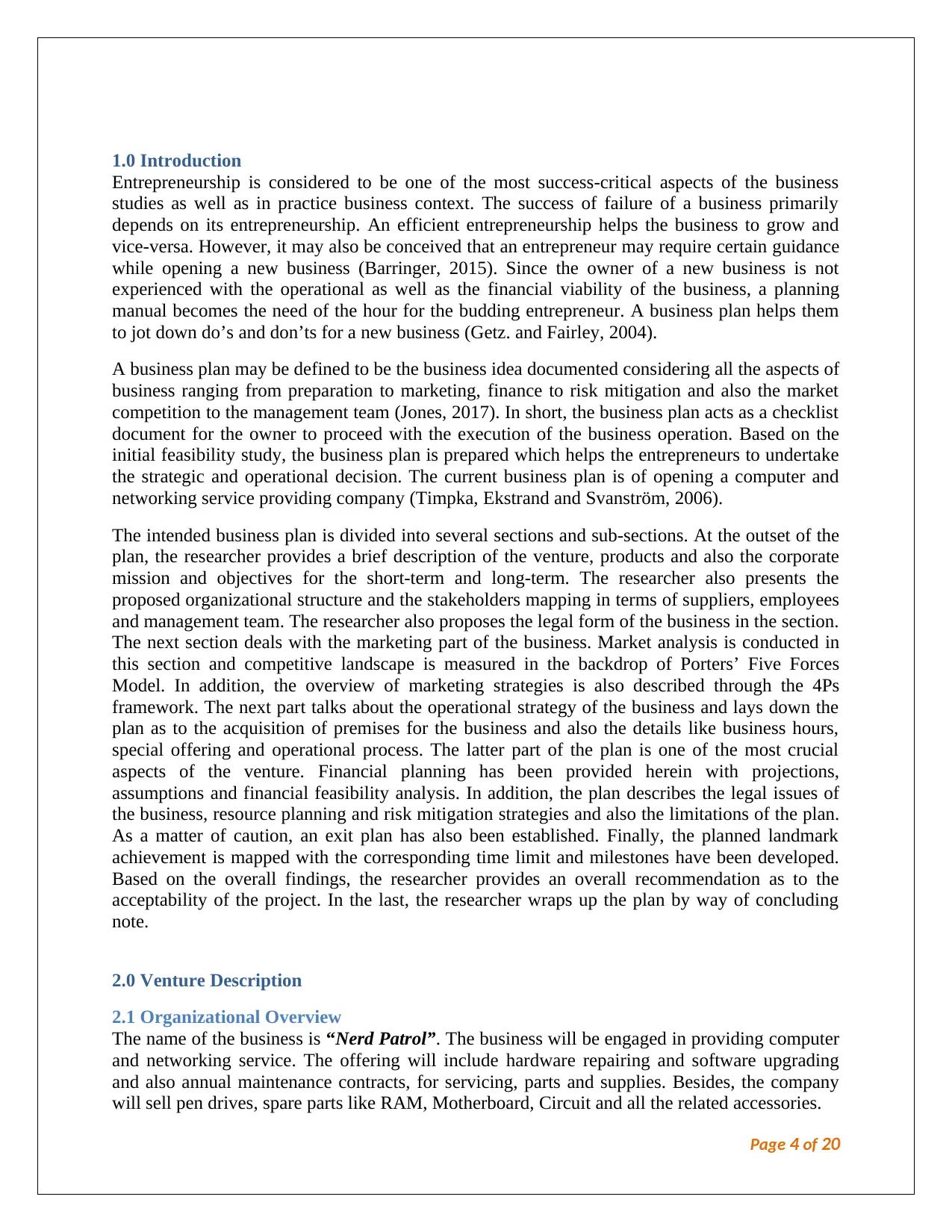
1.0 Introduction
Entrepreneurship is considered to be one of the most success-critical aspects of the business
studies as well as in practice business context. The success of failure of a business primarily
depends on its entrepreneurship. An efficient entrepreneurship helps the business to grow and
vice-versa. However, it may also be conceived that an entrepreneur may require certain guidance
while opening a new business (Barringer, 2015). Since the owner of a new business is not
experienced with the operational as well as the financial viability of the business, a planning
manual becomes the need of the hour for the budding entrepreneur. A business plan helps them
to jot down do’s and don’ts for a new business (Getz. and Fairley, 2004).
A business plan may be defined to be the business idea documented considering all the aspects of
business ranging from preparation to marketing, finance to risk mitigation and also the market
competition to the management team (Jones, 2017). In short, the business plan acts as a checklist
document for the owner to proceed with the execution of the business operation. Based on the
initial feasibility study, the business plan is prepared which helps the entrepreneurs to undertake
the strategic and operational decision. The current business plan is of opening a computer and
networking service providing company (Timpka, Ekstrand and Svanström, 2006).
The intended business plan is divided into several sections and sub-sections. At the outset of the
plan, the researcher provides a brief description of the venture, products and also the corporate
mission and objectives for the short-term and long-term. The researcher also presents the
proposed organizational structure and the stakeholders mapping in terms of suppliers, employees
and management team. The researcher also proposes the legal form of the business in the section.
The next section deals with the marketing part of the business. Market analysis is conducted in
this section and competitive landscape is measured in the backdrop of Porters’ Five Forces
Model. In addition, the overview of marketing strategies is also described through the 4Ps
framework. The next part talks about the operational strategy of the business and lays down the
plan as to the acquisition of premises for the business and also the details like business hours,
special offering and operational process. The latter part of the plan is one of the most crucial
aspects of the venture. Financial planning has been provided herein with projections,
assumptions and financial feasibility analysis. In addition, the plan describes the legal issues of
the business, resource planning and risk mitigation strategies and also the limitations of the plan.
As a matter of caution, an exit plan has also been established. Finally, the planned landmark
achievement is mapped with the corresponding time limit and milestones have been developed.
Based on the overall findings, the researcher provides an overall recommendation as to the
acceptability of the project. In the last, the researcher wraps up the plan by way of concluding
note.
2.0 Venture Description
2.1 Organizational Overview
The name of the business is “Nerd Patrol”. The business will be engaged in providing computer
and networking service. The offering will include hardware repairing and software upgrading
and also annual maintenance contracts, for servicing, parts and supplies. Besides, the company
will sell pen drives, spare parts like RAM, Motherboard, Circuit and all the related accessories.
Page 4 of 20
Entrepreneurship is considered to be one of the most success-critical aspects of the business
studies as well as in practice business context. The success of failure of a business primarily
depends on its entrepreneurship. An efficient entrepreneurship helps the business to grow and
vice-versa. However, it may also be conceived that an entrepreneur may require certain guidance
while opening a new business (Barringer, 2015). Since the owner of a new business is not
experienced with the operational as well as the financial viability of the business, a planning
manual becomes the need of the hour for the budding entrepreneur. A business plan helps them
to jot down do’s and don’ts for a new business (Getz. and Fairley, 2004).
A business plan may be defined to be the business idea documented considering all the aspects of
business ranging from preparation to marketing, finance to risk mitigation and also the market
competition to the management team (Jones, 2017). In short, the business plan acts as a checklist
document for the owner to proceed with the execution of the business operation. Based on the
initial feasibility study, the business plan is prepared which helps the entrepreneurs to undertake
the strategic and operational decision. The current business plan is of opening a computer and
networking service providing company (Timpka, Ekstrand and Svanström, 2006).
The intended business plan is divided into several sections and sub-sections. At the outset of the
plan, the researcher provides a brief description of the venture, products and also the corporate
mission and objectives for the short-term and long-term. The researcher also presents the
proposed organizational structure and the stakeholders mapping in terms of suppliers, employees
and management team. The researcher also proposes the legal form of the business in the section.
The next section deals with the marketing part of the business. Market analysis is conducted in
this section and competitive landscape is measured in the backdrop of Porters’ Five Forces
Model. In addition, the overview of marketing strategies is also described through the 4Ps
framework. The next part talks about the operational strategy of the business and lays down the
plan as to the acquisition of premises for the business and also the details like business hours,
special offering and operational process. The latter part of the plan is one of the most crucial
aspects of the venture. Financial planning has been provided herein with projections,
assumptions and financial feasibility analysis. In addition, the plan describes the legal issues of
the business, resource planning and risk mitigation strategies and also the limitations of the plan.
As a matter of caution, an exit plan has also been established. Finally, the planned landmark
achievement is mapped with the corresponding time limit and milestones have been developed.
Based on the overall findings, the researcher provides an overall recommendation as to the
acceptability of the project. In the last, the researcher wraps up the plan by way of concluding
note.
2.0 Venture Description
2.1 Organizational Overview
The name of the business is “Nerd Patrol”. The business will be engaged in providing computer
and networking service. The offering will include hardware repairing and software upgrading
and also annual maintenance contracts, for servicing, parts and supplies. Besides, the company
will sell pen drives, spare parts like RAM, Motherboard, Circuit and all the related accessories.
Page 4 of 20
Paraphrase This Document
Need a fresh take? Get an instant paraphrase of this document with our AI Paraphraser
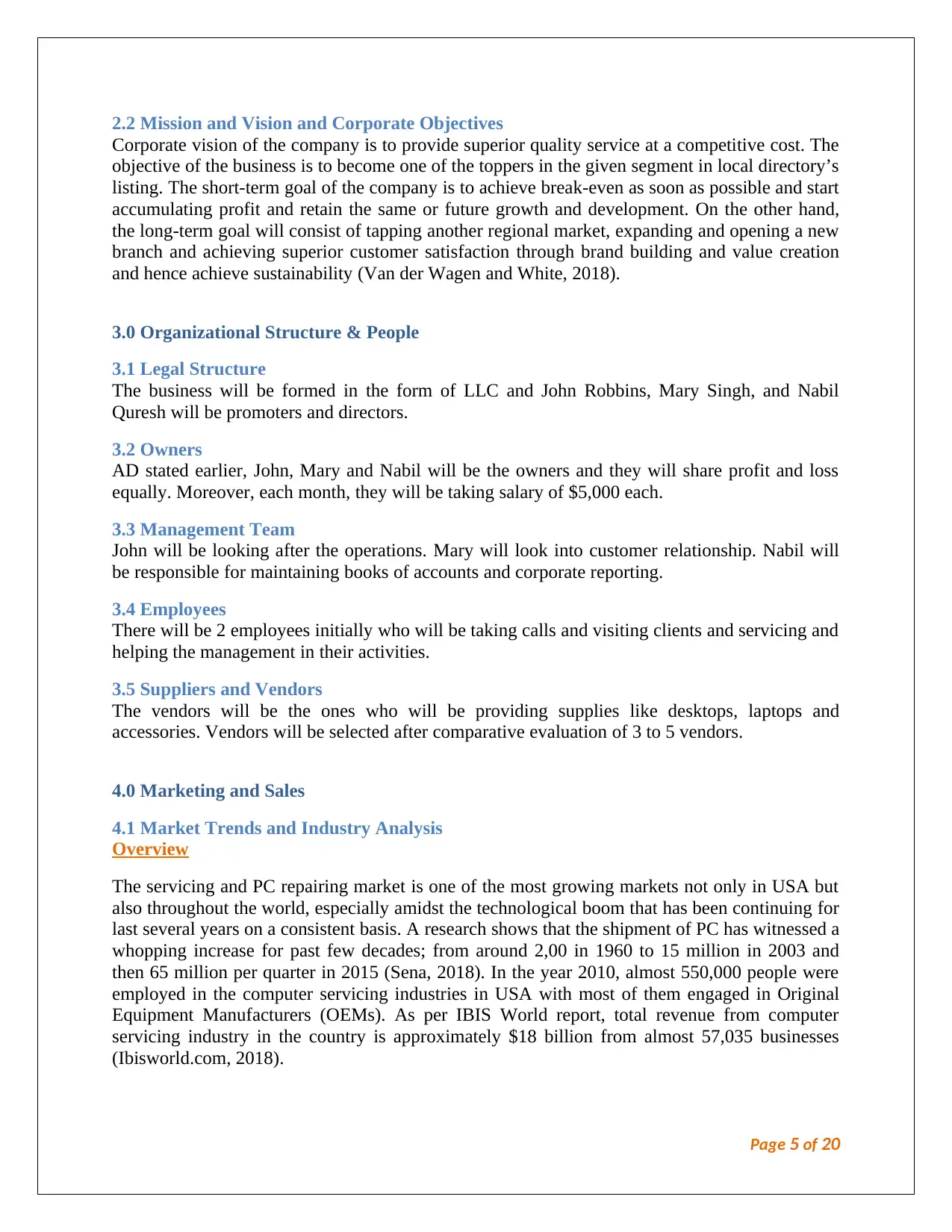
2.2 Mission and Vision and Corporate Objectives
Corporate vision of the company is to provide superior quality service at a competitive cost. The
objective of the business is to become one of the toppers in the given segment in local directory’s
listing. The short-term goal of the company is to achieve break-even as soon as possible and start
accumulating profit and retain the same or future growth and development. On the other hand,
the long-term goal will consist of tapping another regional market, expanding and opening a new
branch and achieving superior customer satisfaction through brand building and value creation
and hence achieve sustainability (Van der Wagen and White, 2018).
3.0 Organizational Structure & People
3.1 Legal Structure
The business will be formed in the form of LLC and John Robbins, Mary Singh, and Nabil
Quresh will be promoters and directors.
3.2 Owners
AD stated earlier, John, Mary and Nabil will be the owners and they will share profit and loss
equally. Moreover, each month, they will be taking salary of $5,000 each.
3.3 Management Team
John will be looking after the operations. Mary will look into customer relationship. Nabil will
be responsible for maintaining books of accounts and corporate reporting.
3.4 Employees
There will be 2 employees initially who will be taking calls and visiting clients and servicing and
helping the management in their activities.
3.5 Suppliers and Vendors
The vendors will be the ones who will be providing supplies like desktops, laptops and
accessories. Vendors will be selected after comparative evaluation of 3 to 5 vendors.
4.0 Marketing and Sales
4.1 Market Trends and Industry Analysis
Overview
The servicing and PC repairing market is one of the most growing markets not only in USA but
also throughout the world, especially amidst the technological boom that has been continuing for
last several years on a consistent basis. A research shows that the shipment of PC has witnessed a
whopping increase for past few decades; from around 2,00 in 1960 to 15 million in 2003 and
then 65 million per quarter in 2015 (Sena, 2018). In the year 2010, almost 550,000 people were
employed in the computer servicing industries in USA with most of them engaged in Original
Equipment Manufacturers (OEMs). As per IBIS World report, total revenue from computer
servicing industry in the country is approximately $18 billion from almost 57,035 businesses
(Ibisworld.com, 2018).
Page 5 of 20
Corporate vision of the company is to provide superior quality service at a competitive cost. The
objective of the business is to become one of the toppers in the given segment in local directory’s
listing. The short-term goal of the company is to achieve break-even as soon as possible and start
accumulating profit and retain the same or future growth and development. On the other hand,
the long-term goal will consist of tapping another regional market, expanding and opening a new
branch and achieving superior customer satisfaction through brand building and value creation
and hence achieve sustainability (Van der Wagen and White, 2018).
3.0 Organizational Structure & People
3.1 Legal Structure
The business will be formed in the form of LLC and John Robbins, Mary Singh, and Nabil
Quresh will be promoters and directors.
3.2 Owners
AD stated earlier, John, Mary and Nabil will be the owners and they will share profit and loss
equally. Moreover, each month, they will be taking salary of $5,000 each.
3.3 Management Team
John will be looking after the operations. Mary will look into customer relationship. Nabil will
be responsible for maintaining books of accounts and corporate reporting.
3.4 Employees
There will be 2 employees initially who will be taking calls and visiting clients and servicing and
helping the management in their activities.
3.5 Suppliers and Vendors
The vendors will be the ones who will be providing supplies like desktops, laptops and
accessories. Vendors will be selected after comparative evaluation of 3 to 5 vendors.
4.0 Marketing and Sales
4.1 Market Trends and Industry Analysis
Overview
The servicing and PC repairing market is one of the most growing markets not only in USA but
also throughout the world, especially amidst the technological boom that has been continuing for
last several years on a consistent basis. A research shows that the shipment of PC has witnessed a
whopping increase for past few decades; from around 2,00 in 1960 to 15 million in 2003 and
then 65 million per quarter in 2015 (Sena, 2018). In the year 2010, almost 550,000 people were
employed in the computer servicing industries in USA with most of them engaged in Original
Equipment Manufacturers (OEMs). As per IBIS World report, total revenue from computer
servicing industry in the country is approximately $18 billion from almost 57,035 businesses
(Ibisworld.com, 2018).
Page 5 of 20
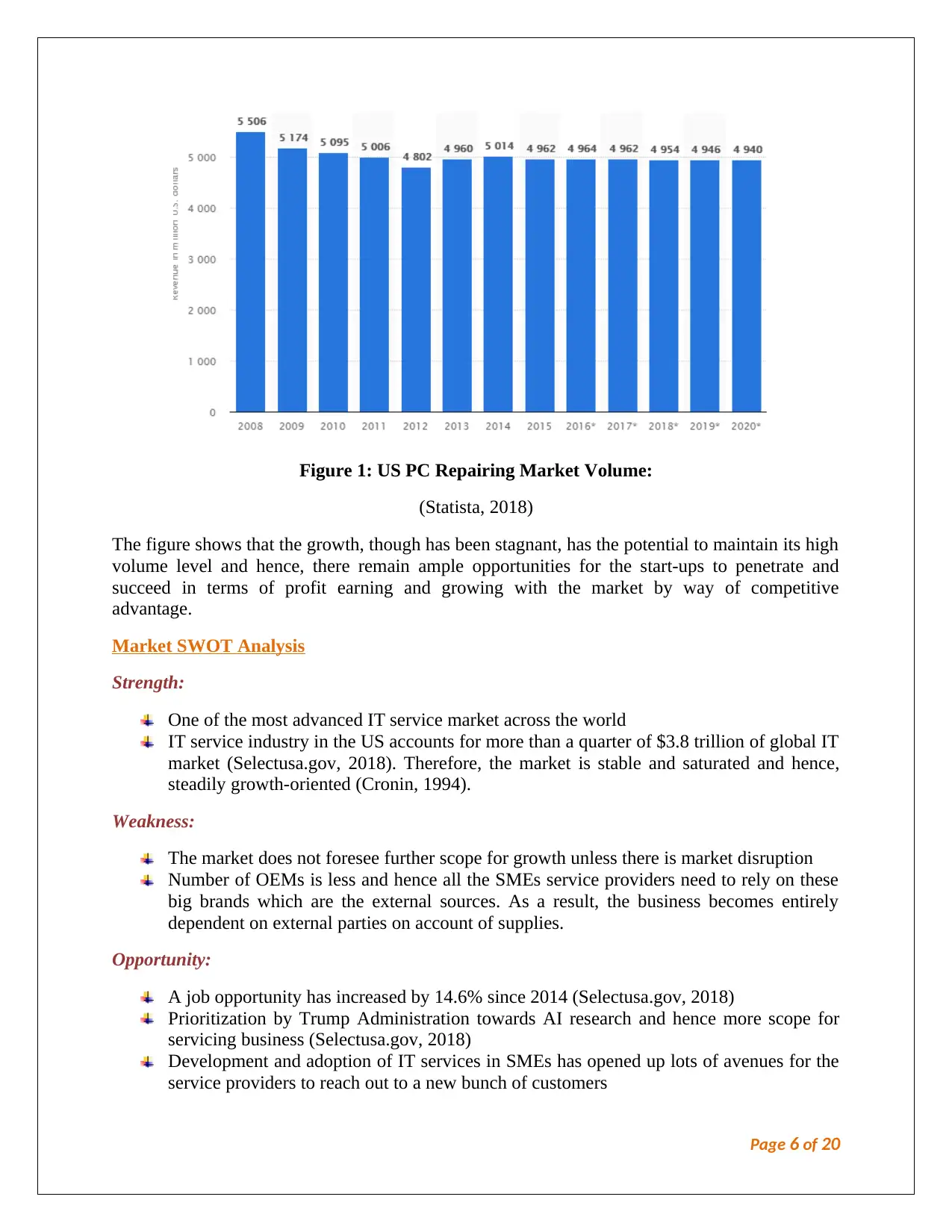
Figure 1: US PC Repairing Market Volume:
(Statista, 2018)
The figure shows that the growth, though has been stagnant, has the potential to maintain its high
volume level and hence, there remain ample opportunities for the start-ups to penetrate and
succeed in terms of profit earning and growing with the market by way of competitive
advantage.
Market SWOT Analysis
Strength:
One of the most advanced IT service market across the world
IT service industry in the US accounts for more than a quarter of $3.8 trillion of global IT
market (Selectusa.gov, 2018). Therefore, the market is stable and saturated and hence,
steadily growth-oriented (Cronin, 1994).
Weakness:
The market does not foresee further scope for growth unless there is market disruption
Number of OEMs is less and hence all the SMEs service providers need to rely on these
big brands which are the external sources. As a result, the business becomes entirely
dependent on external parties on account of supplies.
Opportunity:
A job opportunity has increased by 14.6% since 2014 (Selectusa.gov, 2018)
Prioritization by Trump Administration towards AI research and hence more scope for
servicing business (Selectusa.gov, 2018)
Development and adoption of IT services in SMEs has opened up lots of avenues for the
service providers to reach out to a new bunch of customers
Page 6 of 20
(Statista, 2018)
The figure shows that the growth, though has been stagnant, has the potential to maintain its high
volume level and hence, there remain ample opportunities for the start-ups to penetrate and
succeed in terms of profit earning and growing with the market by way of competitive
advantage.
Market SWOT Analysis
Strength:
One of the most advanced IT service market across the world
IT service industry in the US accounts for more than a quarter of $3.8 trillion of global IT
market (Selectusa.gov, 2018). Therefore, the market is stable and saturated and hence,
steadily growth-oriented (Cronin, 1994).
Weakness:
The market does not foresee further scope for growth unless there is market disruption
Number of OEMs is less and hence all the SMEs service providers need to rely on these
big brands which are the external sources. As a result, the business becomes entirely
dependent on external parties on account of supplies.
Opportunity:
A job opportunity has increased by 14.6% since 2014 (Selectusa.gov, 2018)
Prioritization by Trump Administration towards AI research and hence more scope for
servicing business (Selectusa.gov, 2018)
Development and adoption of IT services in SMEs has opened up lots of avenues for the
service providers to reach out to a new bunch of customers
Page 6 of 20
⊘ This is a preview!⊘
Do you want full access?
Subscribe today to unlock all pages.

Trusted by 1+ million students worldwide
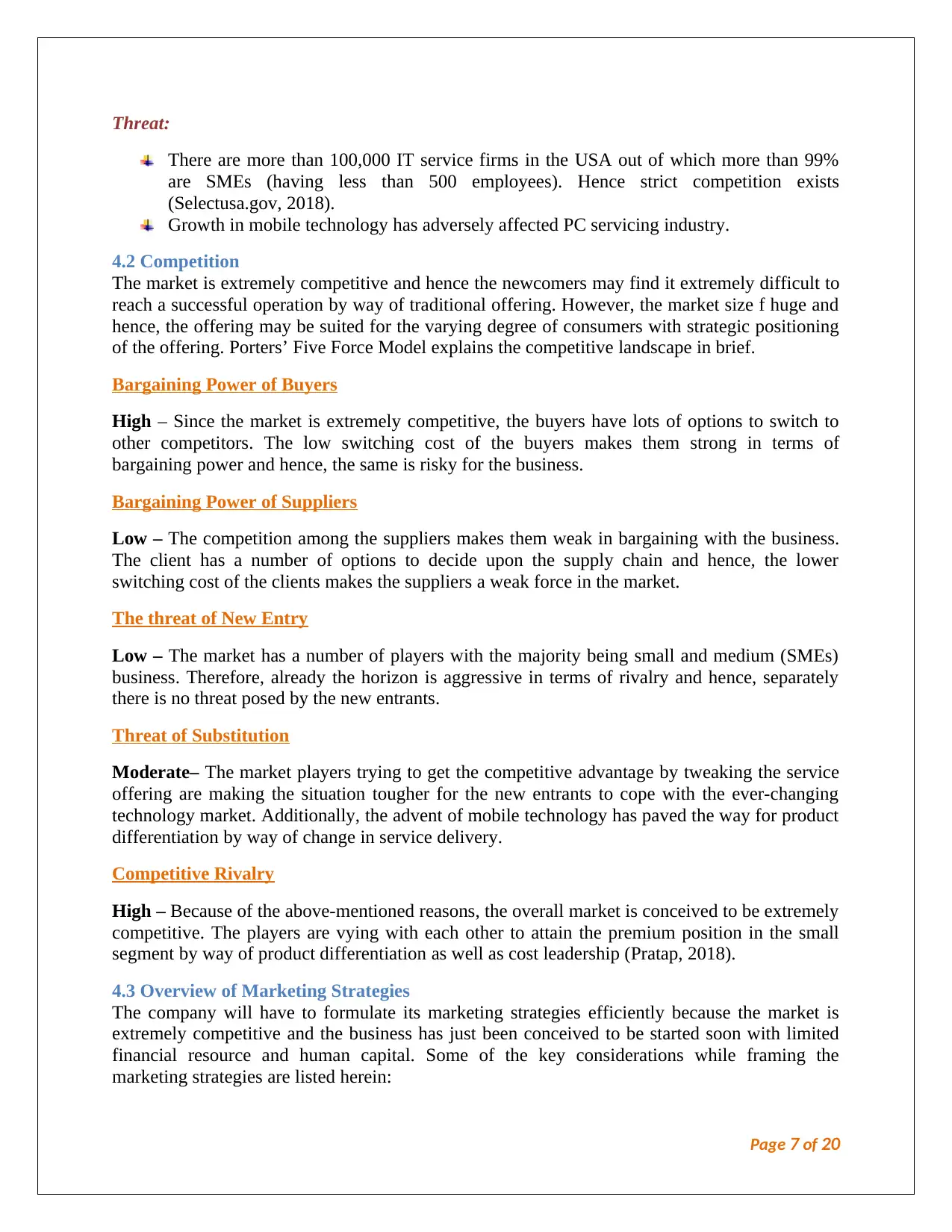
Threat:
There are more than 100,000 IT service firms in the USA out of which more than 99%
are SMEs (having less than 500 employees). Hence strict competition exists
(Selectusa.gov, 2018).
Growth in mobile technology has adversely affected PC servicing industry.
4.2 Competition
The market is extremely competitive and hence the newcomers may find it extremely difficult to
reach a successful operation by way of traditional offering. However, the market size f huge and
hence, the offering may be suited for the varying degree of consumers with strategic positioning
of the offering. Porters’ Five Force Model explains the competitive landscape in brief.
Bargaining Power of Buyers
High – Since the market is extremely competitive, the buyers have lots of options to switch to
other competitors. The low switching cost of the buyers makes them strong in terms of
bargaining power and hence, the same is risky for the business.
Bargaining Power of Suppliers
Low – The competition among the suppliers makes them weak in bargaining with the business.
The client has a number of options to decide upon the supply chain and hence, the lower
switching cost of the clients makes the suppliers a weak force in the market.
The threat of New Entry
Low – The market has a number of players with the majority being small and medium (SMEs)
business. Therefore, already the horizon is aggressive in terms of rivalry and hence, separately
there is no threat posed by the new entrants.
Threat of Substitution
Moderate– The market players trying to get the competitive advantage by tweaking the service
offering are making the situation tougher for the new entrants to cope with the ever-changing
technology market. Additionally, the advent of mobile technology has paved the way for product
differentiation by way of change in service delivery.
Competitive Rivalry
High – Because of the above-mentioned reasons, the overall market is conceived to be extremely
competitive. The players are vying with each other to attain the premium position in the small
segment by way of product differentiation as well as cost leadership (Pratap, 2018).
4.3 Overview of Marketing Strategies
The company will have to formulate its marketing strategies efficiently because the market is
extremely competitive and the business has just been conceived to be started soon with limited
financial resource and human capital. Some of the key considerations while framing the
marketing strategies are listed herein:
Page 7 of 20
There are more than 100,000 IT service firms in the USA out of which more than 99%
are SMEs (having less than 500 employees). Hence strict competition exists
(Selectusa.gov, 2018).
Growth in mobile technology has adversely affected PC servicing industry.
4.2 Competition
The market is extremely competitive and hence the newcomers may find it extremely difficult to
reach a successful operation by way of traditional offering. However, the market size f huge and
hence, the offering may be suited for the varying degree of consumers with strategic positioning
of the offering. Porters’ Five Force Model explains the competitive landscape in brief.
Bargaining Power of Buyers
High – Since the market is extremely competitive, the buyers have lots of options to switch to
other competitors. The low switching cost of the buyers makes them strong in terms of
bargaining power and hence, the same is risky for the business.
Bargaining Power of Suppliers
Low – The competition among the suppliers makes them weak in bargaining with the business.
The client has a number of options to decide upon the supply chain and hence, the lower
switching cost of the clients makes the suppliers a weak force in the market.
The threat of New Entry
Low – The market has a number of players with the majority being small and medium (SMEs)
business. Therefore, already the horizon is aggressive in terms of rivalry and hence, separately
there is no threat posed by the new entrants.
Threat of Substitution
Moderate– The market players trying to get the competitive advantage by tweaking the service
offering are making the situation tougher for the new entrants to cope with the ever-changing
technology market. Additionally, the advent of mobile technology has paved the way for product
differentiation by way of change in service delivery.
Competitive Rivalry
High – Because of the above-mentioned reasons, the overall market is conceived to be extremely
competitive. The players are vying with each other to attain the premium position in the small
segment by way of product differentiation as well as cost leadership (Pratap, 2018).
4.3 Overview of Marketing Strategies
The company will have to formulate its marketing strategies efficiently because the market is
extremely competitive and the business has just been conceived to be started soon with limited
financial resource and human capital. Some of the key considerations while framing the
marketing strategies are listed herein:
Page 7 of 20
Paraphrase This Document
Need a fresh take? Get an instant paraphrase of this document with our AI Paraphraser
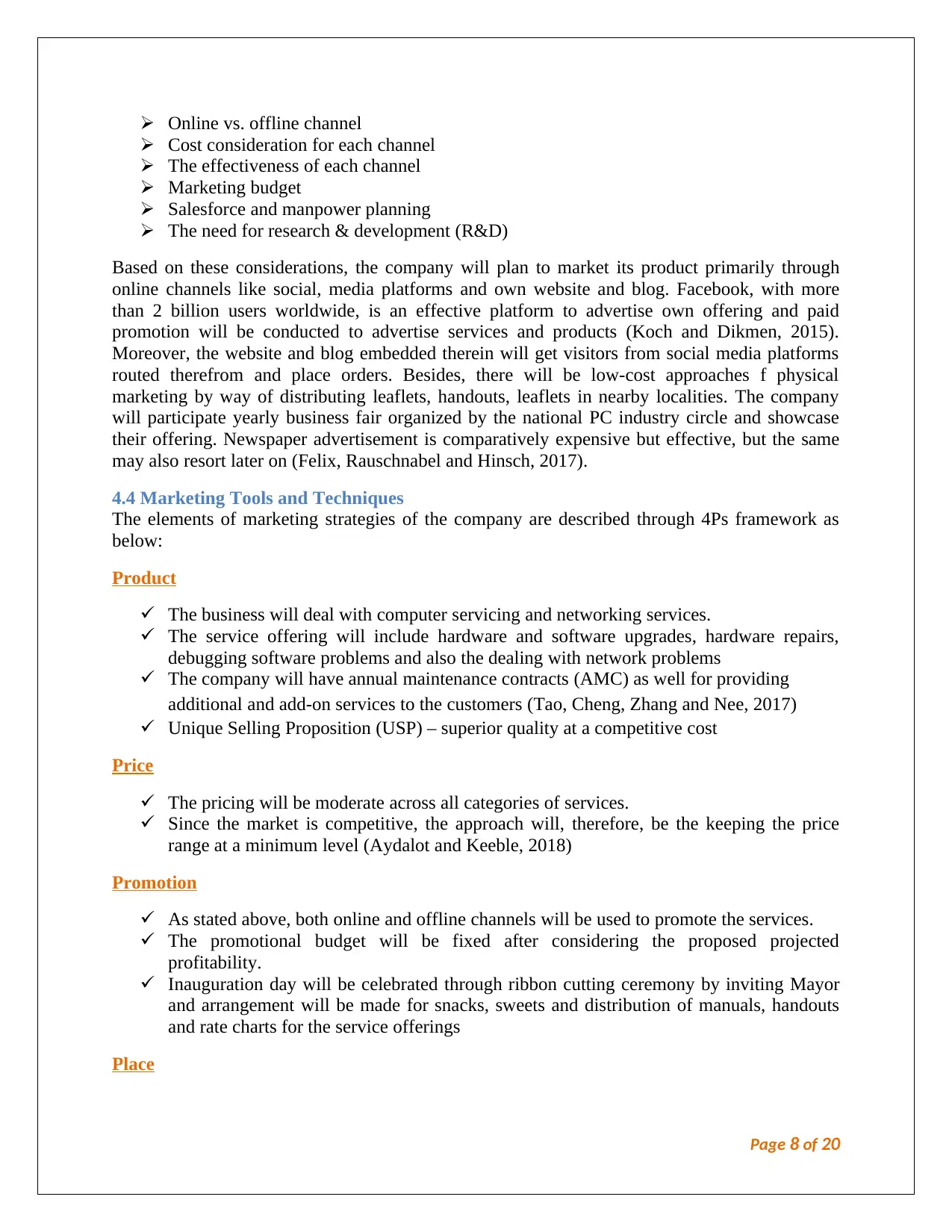
Online vs. offline channel
Cost consideration for each channel
The effectiveness of each channel
Marketing budget
Salesforce and manpower planning
The need for research & development (R&D)
Based on these considerations, the company will plan to market its product primarily through
online channels like social, media platforms and own website and blog. Facebook, with more
than 2 billion users worldwide, is an effective platform to advertise own offering and paid
promotion will be conducted to advertise services and products (Koch and Dikmen, 2015).
Moreover, the website and blog embedded therein will get visitors from social media platforms
routed therefrom and place orders. Besides, there will be low-cost approaches f physical
marketing by way of distributing leaflets, handouts, leaflets in nearby localities. The company
will participate yearly business fair organized by the national PC industry circle and showcase
their offering. Newspaper advertisement is comparatively expensive but effective, but the same
may also resort later on (Felix, Rauschnabel and Hinsch, 2017).
4.4 Marketing Tools and Techniques
The elements of marketing strategies of the company are described through 4Ps framework as
below:
Product
The business will deal with computer servicing and networking services.
The service offering will include hardware and software upgrades, hardware repairs,
debugging software problems and also the dealing with network problems
The company will have annual maintenance contracts (AMC) as well for providing
additional and add-on services to the customers (Tao, Cheng, Zhang and Nee, 2017)
Unique Selling Proposition (USP) – superior quality at a competitive cost
Price
The pricing will be moderate across all categories of services.
Since the market is competitive, the approach will, therefore, be the keeping the price
range at a minimum level (Aydalot and Keeble, 2018)
Promotion
As stated above, both online and offline channels will be used to promote the services.
The promotional budget will be fixed after considering the proposed projected
profitability.
Inauguration day will be celebrated through ribbon cutting ceremony by inviting Mayor
and arrangement will be made for snacks, sweets and distribution of manuals, handouts
and rate charts for the service offerings
Place
Page 8 of 20
Cost consideration for each channel
The effectiveness of each channel
Marketing budget
Salesforce and manpower planning
The need for research & development (R&D)
Based on these considerations, the company will plan to market its product primarily through
online channels like social, media platforms and own website and blog. Facebook, with more
than 2 billion users worldwide, is an effective platform to advertise own offering and paid
promotion will be conducted to advertise services and products (Koch and Dikmen, 2015).
Moreover, the website and blog embedded therein will get visitors from social media platforms
routed therefrom and place orders. Besides, there will be low-cost approaches f physical
marketing by way of distributing leaflets, handouts, leaflets in nearby localities. The company
will participate yearly business fair organized by the national PC industry circle and showcase
their offering. Newspaper advertisement is comparatively expensive but effective, but the same
may also resort later on (Felix, Rauschnabel and Hinsch, 2017).
4.4 Marketing Tools and Techniques
The elements of marketing strategies of the company are described through 4Ps framework as
below:
Product
The business will deal with computer servicing and networking services.
The service offering will include hardware and software upgrades, hardware repairs,
debugging software problems and also the dealing with network problems
The company will have annual maintenance contracts (AMC) as well for providing
additional and add-on services to the customers (Tao, Cheng, Zhang and Nee, 2017)
Unique Selling Proposition (USP) – superior quality at a competitive cost
Price
The pricing will be moderate across all categories of services.
Since the market is competitive, the approach will, therefore, be the keeping the price
range at a minimum level (Aydalot and Keeble, 2018)
Promotion
As stated above, both online and offline channels will be used to promote the services.
The promotional budget will be fixed after considering the proposed projected
profitability.
Inauguration day will be celebrated through ribbon cutting ceremony by inviting Mayor
and arrangement will be made for snacks, sweets and distribution of manuals, handouts
and rate charts for the service offerings
Place
Page 8 of 20
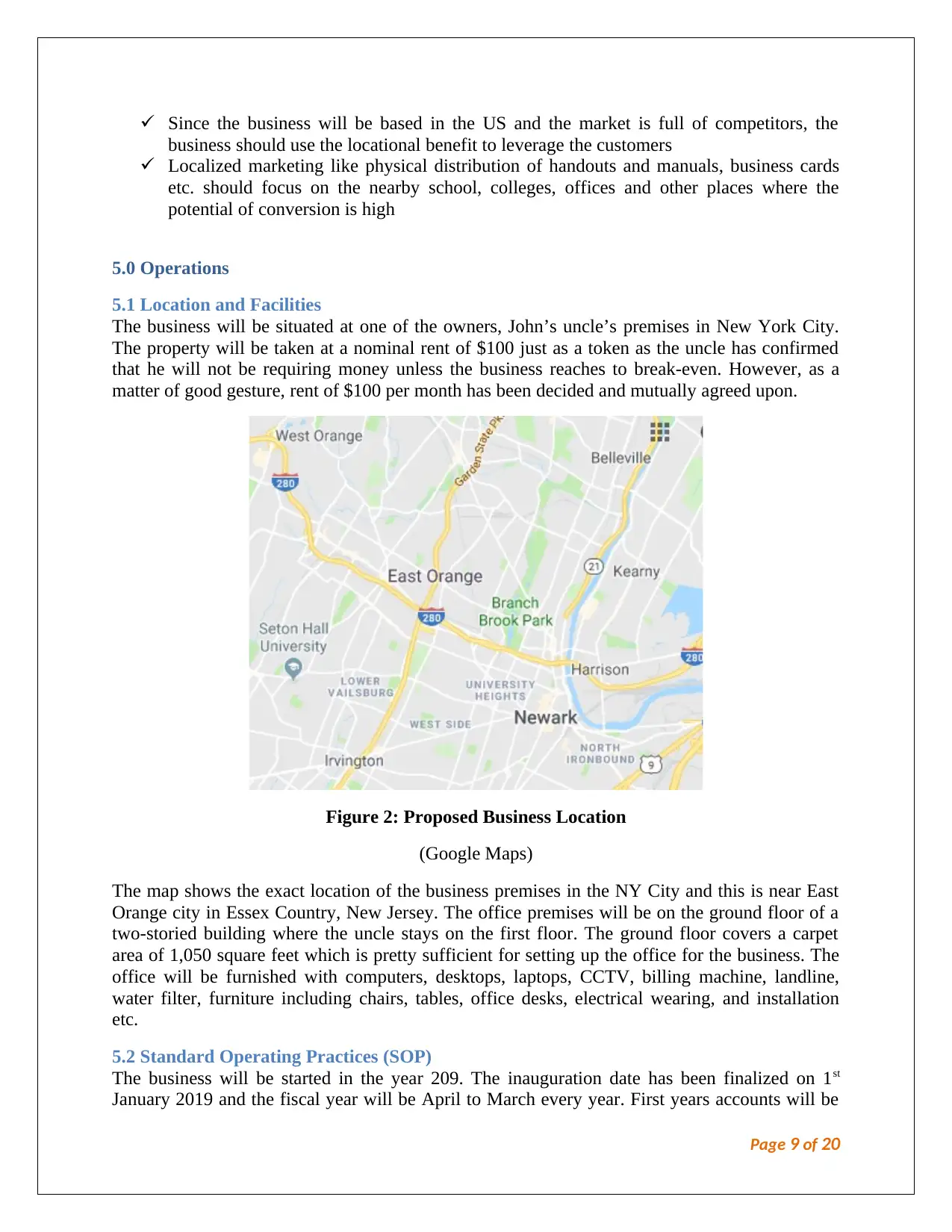
Since the business will be based in the US and the market is full of competitors, the
business should use the locational benefit to leverage the customers
Localized marketing like physical distribution of handouts and manuals, business cards
etc. should focus on the nearby school, colleges, offices and other places where the
potential of conversion is high
5.0 Operations
5.1 Location and Facilities
The business will be situated at one of the owners, John’s uncle’s premises in New York City.
The property will be taken at a nominal rent of $100 just as a token as the uncle has confirmed
that he will not be requiring money unless the business reaches to break-even. However, as a
matter of good gesture, rent of $100 per month has been decided and mutually agreed upon.
Figure 2: Proposed Business Location
(Google Maps)
The map shows the exact location of the business premises in the NY City and this is near East
Orange city in Essex Country, New Jersey. The office premises will be on the ground floor of a
two-storied building where the uncle stays on the first floor. The ground floor covers a carpet
area of 1,050 square feet which is pretty sufficient for setting up the office for the business. The
office will be furnished with computers, desktops, laptops, CCTV, billing machine, landline,
water filter, furniture including chairs, tables, office desks, electrical wearing, and installation
etc.
5.2 Standard Operating Practices (SOP)
The business will be started in the year 209. The inauguration date has been finalized on 1st
January 2019 and the fiscal year will be April to March every year. First years accounts will be
Page 9 of 20
business should use the locational benefit to leverage the customers
Localized marketing like physical distribution of handouts and manuals, business cards
etc. should focus on the nearby school, colleges, offices and other places where the
potential of conversion is high
5.0 Operations
5.1 Location and Facilities
The business will be situated at one of the owners, John’s uncle’s premises in New York City.
The property will be taken at a nominal rent of $100 just as a token as the uncle has confirmed
that he will not be requiring money unless the business reaches to break-even. However, as a
matter of good gesture, rent of $100 per month has been decided and mutually agreed upon.
Figure 2: Proposed Business Location
(Google Maps)
The map shows the exact location of the business premises in the NY City and this is near East
Orange city in Essex Country, New Jersey. The office premises will be on the ground floor of a
two-storied building where the uncle stays on the first floor. The ground floor covers a carpet
area of 1,050 square feet which is pretty sufficient for setting up the office for the business. The
office will be furnished with computers, desktops, laptops, CCTV, billing machine, landline,
water filter, furniture including chairs, tables, office desks, electrical wearing, and installation
etc.
5.2 Standard Operating Practices (SOP)
The business will be started in the year 209. The inauguration date has been finalized on 1st
January 2019 and the fiscal year will be April to March every year. First years accounts will be
Page 9 of 20
⊘ This is a preview!⊘
Do you want full access?
Subscribe today to unlock all pages.

Trusted by 1+ million students worldwide
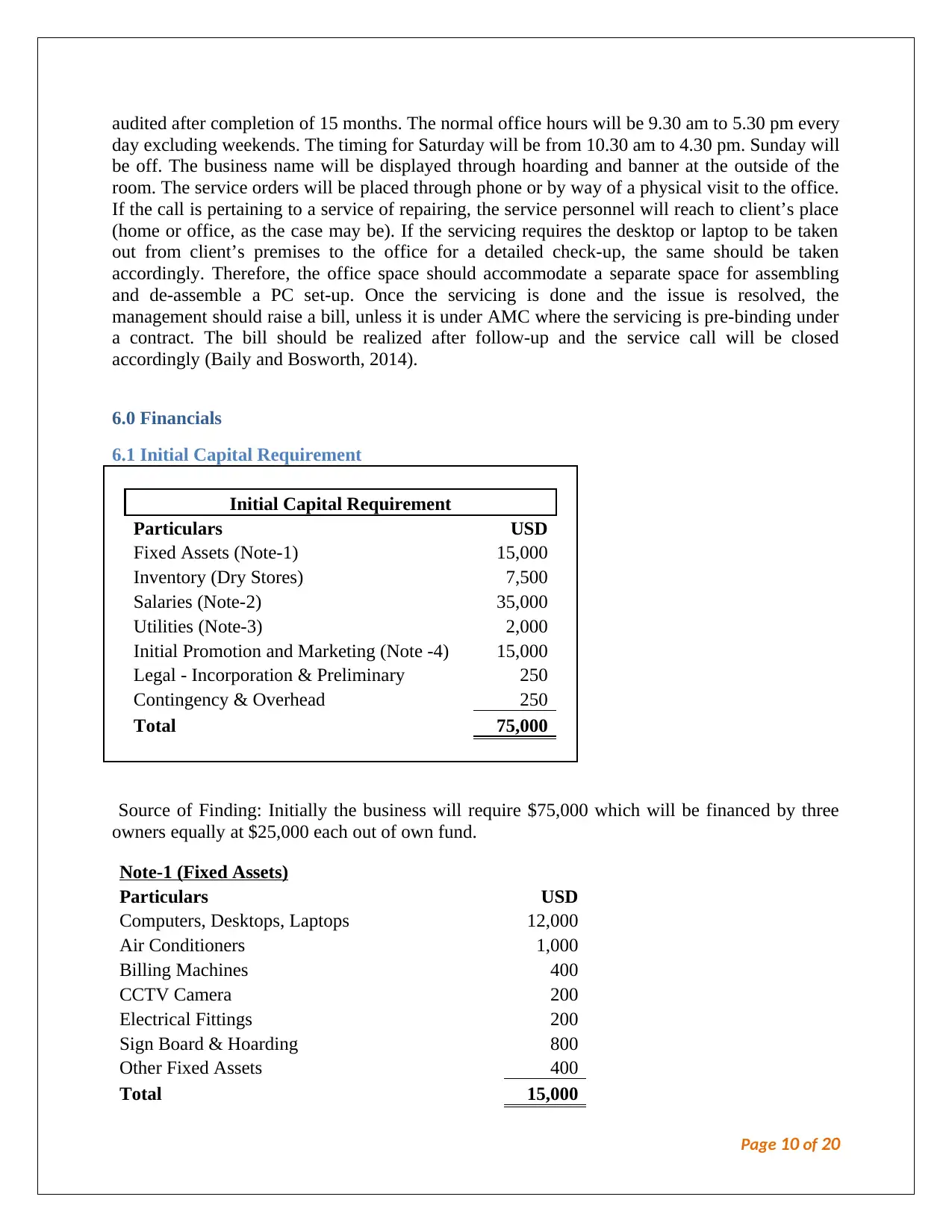
audited after completion of 15 months. The normal office hours will be 9.30 am to 5.30 pm every
day excluding weekends. The timing for Saturday will be from 10.30 am to 4.30 pm. Sunday will
be off. The business name will be displayed through hoarding and banner at the outside of the
room. The service orders will be placed through phone or by way of a physical visit to the office.
If the call is pertaining to a service of repairing, the service personnel will reach to client’s place
(home or office, as the case may be). If the servicing requires the desktop or laptop to be taken
out from client’s premises to the office for a detailed check-up, the same should be taken
accordingly. Therefore, the office space should accommodate a separate space for assembling
and de-assemble a PC set-up. Once the servicing is done and the issue is resolved, the
management should raise a bill, unless it is under AMC where the servicing is pre-binding under
a contract. The bill should be realized after follow-up and the service call will be closed
accordingly (Baily and Bosworth, 2014).
6.0 Financials
6.1 Initial Capital Requirement
Initial Capital Requirement
Particulars USD
Fixed Assets (Note-1) 15,000
Inventory (Dry Stores) 7,500
Salaries (Note-2) 35,000
Utilities (Note-3) 2,000
Initial Promotion and Marketing (Note -4) 15,000
Legal - Incorporation & Preliminary 250
Contingency & Overhead 250
Total 75,000
Source of Finding: Initially the business will require $75,000 which will be financed by three
owners equally at $25,000 each out of own fund.
Note-1 (Fixed Assets)
Particulars USD
Computers, Desktops, Laptops 12,000
Air Conditioners 1,000
Billing Machines 400
CCTV Camera 200
Electrical Fittings 200
Sign Board & Hoarding 800
Other Fixed Assets 400
Total 15,000
Page 10 of 20
day excluding weekends. The timing for Saturday will be from 10.30 am to 4.30 pm. Sunday will
be off. The business name will be displayed through hoarding and banner at the outside of the
room. The service orders will be placed through phone or by way of a physical visit to the office.
If the call is pertaining to a service of repairing, the service personnel will reach to client’s place
(home or office, as the case may be). If the servicing requires the desktop or laptop to be taken
out from client’s premises to the office for a detailed check-up, the same should be taken
accordingly. Therefore, the office space should accommodate a separate space for assembling
and de-assemble a PC set-up. Once the servicing is done and the issue is resolved, the
management should raise a bill, unless it is under AMC where the servicing is pre-binding under
a contract. The bill should be realized after follow-up and the service call will be closed
accordingly (Baily and Bosworth, 2014).
6.0 Financials
6.1 Initial Capital Requirement
Initial Capital Requirement
Particulars USD
Fixed Assets (Note-1) 15,000
Inventory (Dry Stores) 7,500
Salaries (Note-2) 35,000
Utilities (Note-3) 2,000
Initial Promotion and Marketing (Note -4) 15,000
Legal - Incorporation & Preliminary 250
Contingency & Overhead 250
Total 75,000
Source of Finding: Initially the business will require $75,000 which will be financed by three
owners equally at $25,000 each out of own fund.
Note-1 (Fixed Assets)
Particulars USD
Computers, Desktops, Laptops 12,000
Air Conditioners 1,000
Billing Machines 400
CCTV Camera 200
Electrical Fittings 200
Sign Board & Hoarding 800
Other Fixed Assets 400
Total 15,000
Page 10 of 20
Paraphrase This Document
Need a fresh take? Get an instant paraphrase of this document with our AI Paraphraser
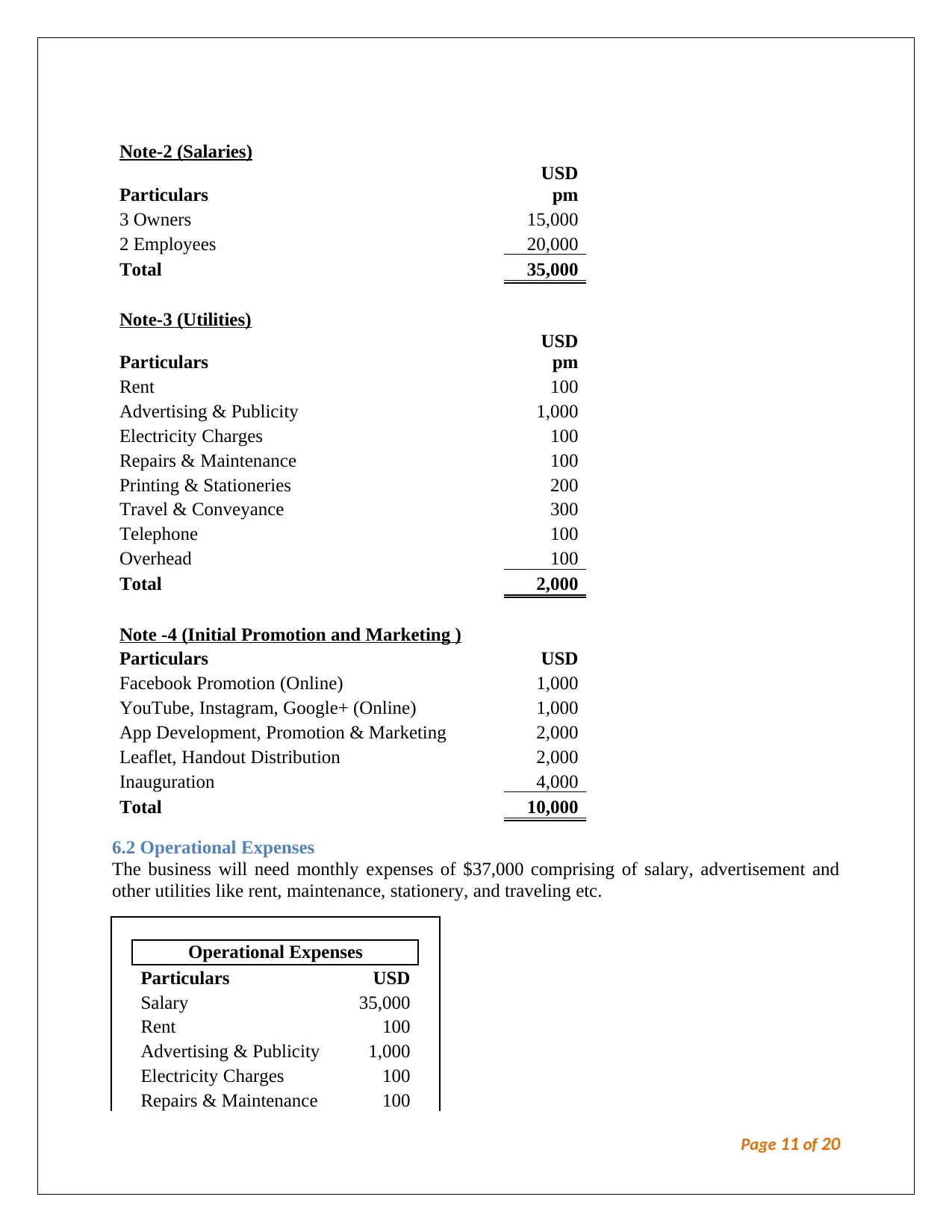
Note-2 (Salaries)
Particulars
USD
pm
3 Owners 15,000
2 Employees 20,000
Total 35,000
Note-3 (Utilities)
Particulars
USD
pm
Rent 100
Advertising & Publicity 1,000
Electricity Charges 100
Repairs & Maintenance 100
Printing & Stationeries 200
Travel & Conveyance 300
Telephone 100
Overhead 100
Total 2,000
Note -4 (Initial Promotion and Marketing )
Particulars USD
Facebook Promotion (Online) 1,000
YouTube, Instagram, Google+ (Online) 1,000
App Development, Promotion & Marketing 2,000
Leaflet, Handout Distribution 2,000
Inauguration 4,000
Total 10,000
6.2 Operational Expenses
The business will need monthly expenses of $37,000 comprising of salary, advertisement and
other utilities like rent, maintenance, stationery, and traveling etc.
Operational Expenses
Particulars USD
Salary 35,000
Rent 100
Advertising & Publicity 1,000
Electricity Charges 100
Repairs & Maintenance 100
Page 11 of 20
Particulars
USD
pm
3 Owners 15,000
2 Employees 20,000
Total 35,000
Note-3 (Utilities)
Particulars
USD
pm
Rent 100
Advertising & Publicity 1,000
Electricity Charges 100
Repairs & Maintenance 100
Printing & Stationeries 200
Travel & Conveyance 300
Telephone 100
Overhead 100
Total 2,000
Note -4 (Initial Promotion and Marketing )
Particulars USD
Facebook Promotion (Online) 1,000
YouTube, Instagram, Google+ (Online) 1,000
App Development, Promotion & Marketing 2,000
Leaflet, Handout Distribution 2,000
Inauguration 4,000
Total 10,000
6.2 Operational Expenses
The business will need monthly expenses of $37,000 comprising of salary, advertisement and
other utilities like rent, maintenance, stationery, and traveling etc.
Operational Expenses
Particulars USD
Salary 35,000
Rent 100
Advertising & Publicity 1,000
Electricity Charges 100
Repairs & Maintenance 100
Page 11 of 20
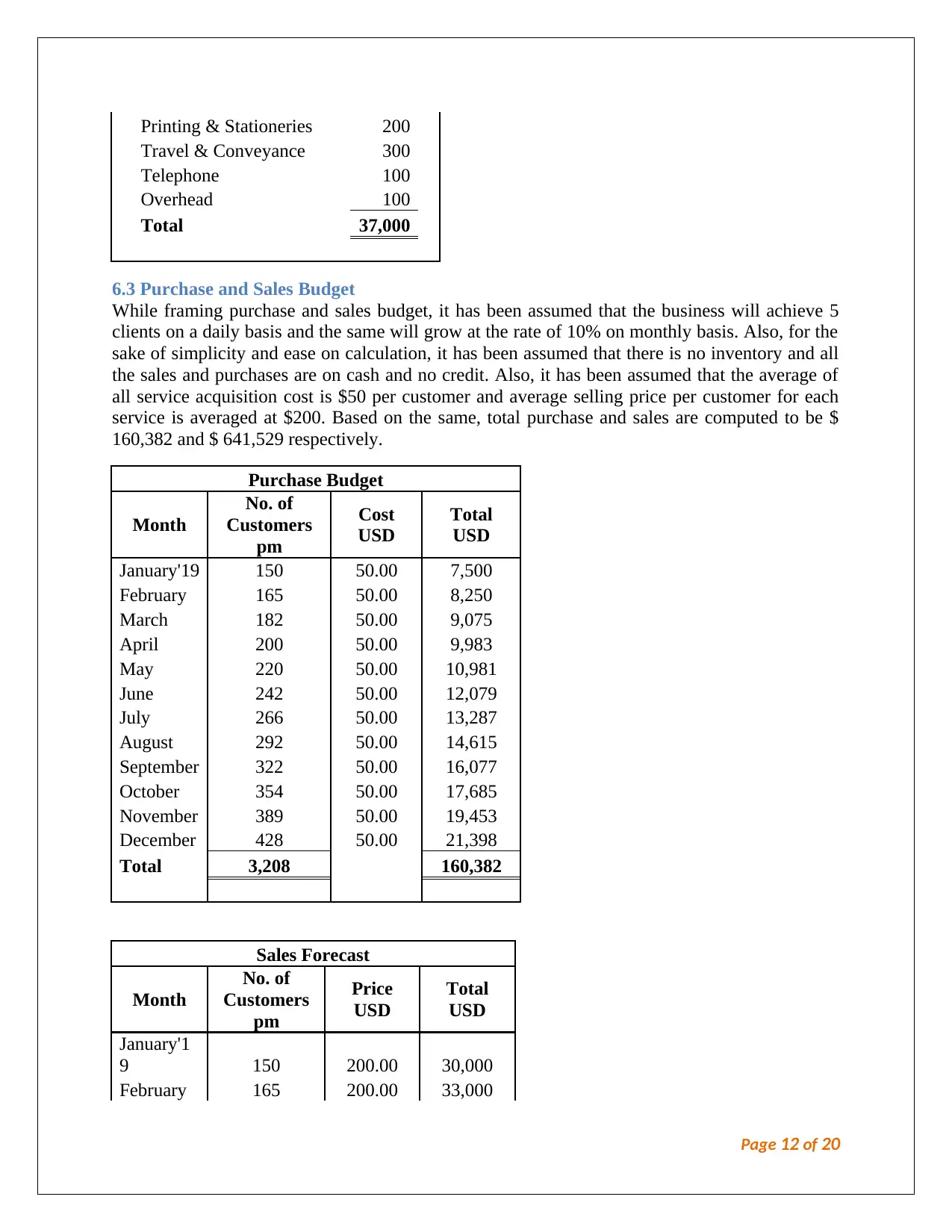
Printing & Stationeries 200
Travel & Conveyance 300
Telephone 100
Overhead 100
Total 37,000
6.3 Purchase and Sales Budget
While framing purchase and sales budget, it has been assumed that the business will achieve 5
clients on a daily basis and the same will grow at the rate of 10% on monthly basis. Also, for the
sake of simplicity and ease on calculation, it has been assumed that there is no inventory and all
the sales and purchases are on cash and no credit. Also, it has been assumed that the average of
all service acquisition cost is $50 per customer and average selling price per customer for each
service is averaged at $200. Based on the same, total purchase and sales are computed to be $
160,382 and $ 641,529 respectively.
Purchase Budget
Month
No. of
Customers
pm
Cost
USD
Total
USD
January'19 150 50.00 7,500
February 165 50.00 8,250
March 182 50.00 9,075
April 200 50.00 9,983
May 220 50.00 10,981
June 242 50.00 12,079
July 266 50.00 13,287
August 292 50.00 14,615
September 322 50.00 16,077
October 354 50.00 17,685
November 389 50.00 19,453
December 428 50.00 21,398
Total 3,208 160,382
Sales Forecast
Month
No. of
Customers
pm
Price
USD
Total
USD
January'1
9 150 200.00 30,000
February 165 200.00 33,000
Page 12 of 20
Travel & Conveyance 300
Telephone 100
Overhead 100
Total 37,000
6.3 Purchase and Sales Budget
While framing purchase and sales budget, it has been assumed that the business will achieve 5
clients on a daily basis and the same will grow at the rate of 10% on monthly basis. Also, for the
sake of simplicity and ease on calculation, it has been assumed that there is no inventory and all
the sales and purchases are on cash and no credit. Also, it has been assumed that the average of
all service acquisition cost is $50 per customer and average selling price per customer for each
service is averaged at $200. Based on the same, total purchase and sales are computed to be $
160,382 and $ 641,529 respectively.
Purchase Budget
Month
No. of
Customers
pm
Cost
USD
Total
USD
January'19 150 50.00 7,500
February 165 50.00 8,250
March 182 50.00 9,075
April 200 50.00 9,983
May 220 50.00 10,981
June 242 50.00 12,079
July 266 50.00 13,287
August 292 50.00 14,615
September 322 50.00 16,077
October 354 50.00 17,685
November 389 50.00 19,453
December 428 50.00 21,398
Total 3,208 160,382
Sales Forecast
Month
No. of
Customers
pm
Price
USD
Total
USD
January'1
9 150 200.00 30,000
February 165 200.00 33,000
Page 12 of 20
⊘ This is a preview!⊘
Do you want full access?
Subscribe today to unlock all pages.

Trusted by 1+ million students worldwide
1 out of 20
Related Documents
Your All-in-One AI-Powered Toolkit for Academic Success.
+13062052269
info@desklib.com
Available 24*7 on WhatsApp / Email
![[object Object]](/_next/static/media/star-bottom.7253800d.svg)
Unlock your academic potential
Copyright © 2020–2025 A2Z Services. All Rights Reserved. Developed and managed by ZUCOL.




